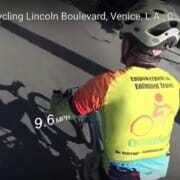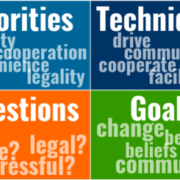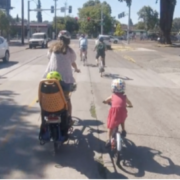Foolhardy, Confidence-Inspiring, or Oddly Uneventful? You Decide
“Worst City to Ride A Bike”
Los Angeles is considered by many to be the worst city in the U.S. to ride a bike. And it sure ain’t because of the climate!
No, it’s believed to be a terrible city to ride because of L.A.’s car-centric transportation culture, high speeds, heavy traffic, and frustrated motorists.
Our wonderful classical music station even plays an “Anti-Road Rage Melody” each weekday at 5 PM in an attempt to soothe the savage beasts — er, L.A. commuting motorists.
K + SI = HIN
Transportation officials love acronyms. L.A.’s transportation officials have special terms for the corridors and intersections with the highest concentration of people killed or seriously injured in cars, on bikes or on foot.
People killed or seriously injured are somberly referred to as “KSIs.” The roads on which these horrific injuries take place are known as part of the “HIN,” or High Injury Network.
Sounds lovely, doesn’t it?
What might it be like to ride a bike on L.A.’s most dangerous streets? Indeed, wouldn’t you have to be crazy to even want to bike on the most dangerous streets in L.A.?
And wouldn’t you have to be even crazier — if possible — to ride during the busiest traffic periods on a weekday morning or late afternoon?
Maybe not.
Riding on the City’s High-Injury Network
What if you were a CyclingSavvy Instructor and program developer wanting to show how CyclingSavvy’s defensive bicycle tips and techniques can make bicycling on L.A.’s most challenging streets easy and fun?
What better place could you choose to make your point than Los Angeles’ High Injury Network?
Hey, if you can bike and stay alive in these conditions, you should be able to bike and thrive anywhere, right!?
Am I Crazy? You Decide
So this spring, after making sure all my affairs were in order, I started shooting traffic cycling videos on High Injury Network roads close to my home in Westside L.A.
The first is Lincoln Boulevard in Venice, between Venice Boulevard and Commonwealth Avenue. This 1.12-mile stretch had 19 KSIs over five years from 2013 to 2017, making it the fifth most dangerous segment in the city during that time period.
Check out the two short videos below. Let me know what you think. Is this foolhardy, confidence-inspiring or oddly uneventful? You can choose more than one!
Northbound on Lincoln Boulevard in Venice, CA
Riding in the Other Direction on Lincoln
See In All Directions With “Pseudo-Drone” Video
I used a “pseudo-drone 360-degree” video technique. This means that if you view these videos on your computer using an updated browser (Chrome and Safari 12.1.1 work) or on your portable device using the YouTube app, you’ll be able to control the direction and zoom of the videos. Using a web browser on your portable device will not allow 360 and zoom control.
Don’t be fooled by the video. I’m not riding fast.
Because the extreme wide-angle perspective of the Garmin VIRB 360 camera makes speeds appear much faster than they are, be sure to check the speed display in the forward and rearward views of the video. You’ll see that I’m usually moving about 15 MPH and often slower on my cargo bike, showing that you don’t have to be a high-speed bicyclist to fit into L.A.’s traffic system.
Disclosure: ABEA is an Amazon affiliate. If you are in the market for a 360 camera and use the link above, your purchase will help us continue our work.








Woo-HOO! What a ride! Looks like the same behavior I get on a similarly lined avenue in my town. There are two lanes of traffic in each direction, and the lanes are basically straight, so motorists have a good line of sight to see the cyclist and plan their move to go around. Watch that road surface, though, lots of gaps and seams to navigate! Is the lighter colored pavement on the right supposed to be a bike lane or parking?
Not a bike lane. It switches from normally a parking lane to an extra travel lane during weekday AM and PM peak traffic times.
Yes, the road surface can be rough in spots. That’s another reason to use the full lane as that gives you plenty of room to maneuver around hazards when necessary. I also like using wide tires on city streets. Even on my non-cargo bikes, I like using 38 to 42 mm wide tires at lower pressure to smooth out the rough spots.
What a ride. I didn’t watch all the way to the end of the videos, but I did see more than half. At the portion I viewed, you had the lane all to yourself, and everyone changed lanes to pass. It shows that good communication through lane placement, really makes a difference in a person’s actual experience of the road. Another thing I saw in several places was how edge riding would put a person in an “unseen” location. Like really in the shadows.
Bethanie, you got that right about lane position being an important form of communication. It’s something we are using to communicate all the time riding in traffic tell drivers behind to either squeeze by in the lane (by riding on the edge), change lanes to pass (by riding toward the center) or not pass at all (left side of lane with “stay-back” hand signal.
My favorite kinds of roads. Whenever I’m biking around and I turn onto a four-lane highway, I actually breathe a sigh of relief, especially if there’s no shoulder. Thanks to CyclingSavvy, those have become some of the easiest and stress-free stretches of my rides. If you’ll permit me, I’d like to counter your videos with one of my own where I’m biking on one of the most difficult roads in Boston–Storrow Drive. https://www.youtube.com/watch?v=rnpM8dVC5PM
Ian, that’s a great (but boring!) video. To me that stretch has a freeway feel which can be even more intimidating than a city street with frequent driveways and intersections, although there are actually more less conflicts.
What’s the posted speed limit on that road?
Ha! It’s supposed to be boring, right? Just like Keri says, that’s the ultimate goal of CyclingSavvy.
The eastern end is posted 30mph and the rest is 40mph, but like you said, it has a freeway feel and motorists (including myself!) tend to go faster than that. There is much heated debate over whether bicycles can be on it but they are legal by Massachusetts law and, as you can see, even a road like that can be tamed. I’m still stunned that it was a taxi driver at the end who let me in front of him into the left lane so I could take the exit.
Thank for sharing these fantastic videos with everybody, Gary and showing us LA isn’t as bad as it sounds for cycling. It is surprising how little traffic there is at this time of day.
Thanks so much Gary for this post and its two accompanying videos! The videos clearly show how driving your bicycle in a savvy matter–no matter where you are–is safe, legal, relevant, cooperative, and FUN!
I look forward to working with you on our looking “left, right, left, and forward” campaign.
I spent over a year (2018-2019) commuting in “The Valley”, mainly on Ventura Blvd, practicing lane control, without incident or a single honk. I still ride there on occasion, but now I’m commuting in Hollywood and the same applies. And here (unlike the Valley where there were few bike commuters) I see others doing the same thing.
It’s great to hear that full lane use by cyclists is catching on in L.A. I like to combine it with making it easy for motorists to pass at convenient and safe opportunities with a thank-you wave. Makes for a positive interaction with our motorized road users.
Great videos! I had a similar productive experience using these riding techniques on a 5000 mile bicycle tour across the US including riding through San Francisco, Los Angeles, San Diego, Tucson, Las Cruces, Amarillo, Oklahoma City, Tulsa, Springfield, St Louis, Cincinnati, Washington DC, Baltimore, Philadelphia, New York City, Providence, Cambridge, Boston as well as many high speed country highways and even a few interstate like roads where there were no other options. Taking the lane works very well. It also helps to wear high visibility clothing as well as have a highly visible bike. I often used day time flashers as well. For more about my ride see ZeroW.org
Tim, that’s quite tour. I did a 3,600 New York city to Oregon coast tour as a lad back in 1970 when I was far from a savvy cyclist. I wish I knew then what we know now!
Thanks, Gary. Are you crazy? Only in the sense that, if you were not making a video to make a point, you would probably have chosen one of the many alternative, more bike-friendly routes rather than taking Lincoln.
I have lived, and cycled, in LA for over 30 years and the few accidents I have had have been on the bike path with pedestrians and, most recently, illegal e-scooters. No problems with drivers.
Actually, I have cycled this and other stretches of Lincoln Boulevard in Venice and Santa Monica many times when not producing a video make a point. I have also used quieter streets which can be more pleasant, but they also have disadvantages. On two-lane streets that have decent connectivity you find many commuters using them in the AM and PM peak travel times. And with only two lanes, it’s difficult for them to pass. So I consider using these streets usually only outside of heavier traffic times.
Unfortunately, L.A. doesn’t have well connected residential streets where through motor traffic is diverted like the Bicycle Boulevards of Berkeley and Portland. So I usually wind up doing most of my bicycling here on the arterials.
When I get back to the office on Monday I’ll check on the types of crashes for our own Orlando area high-severity corridors. I expect the majority of serious crashes involve cyclists riding out into the road from a driveway or side-street, and not overtaking motorist crashes.
That would be great, MIghk.
Do you suspect that transportation officials might have similar useful data for Los Angeles’ high-injury network?
Only if they do crash typing; not many jurisdictions do.
I took a crash typing course in high school. But I suspect that’s unrelated!
Our top ten road sections for bicyclist fatalities and incapacitating injuries (F&I) had a combined 110 F&I crashes over 7 years over 26.2 miles. Of those none involved an overtaking motorist, 27% involved a bicyclist failing to yield (such as mid-block ride-outs or running a signal or stop sign), and 59% a motorist failing to yield (mid-block and side-street drive-outs, right hooks and left crosses). 65% involved cyclists on sidewalks or crosswalks prior to the crash.
That’s SO revealing Mighk, but very predictable– as we as savvy cyclists, educators, and advocates already know.
I pulled traffic collision data of motor vehicles vs. bicyclists–in my city of Yucaipa, CA and next door in Redlands–and similar results.
Unfortunately and not counting you, but city traffic engineers and planners JUST don’t get it–including what the data says. They just continue building bicycle intrastructure to separate and/or remove bicyclists from other users of the road.
Mighk, that’s very interesting and probably surprising to many bicyclists, although probably lane-controlling bicyclists.
Have studies including these findings and other findings like them been published?
I’m working on a comparison of bike lane versus non-bike lane streets (getting bike counts on them now; I have 10 years of crash data for them). But yes, it would be revealing to many people to do a comprehensive look at those highest crash/severity corridors. Of those top ten bike severity corridors, 6 of them have bike lanes or paved shoulders for most of their length (about 16 miles out of the 26). If I expanded to the top 25 corridors it would be more robust data.
Nice ride, Gary! What’s remarkable is that nothing remarkable happens. I believe every car that passes you does so by making a full lane change, and there is no evidence of incivility. The only incident of any note is the “almost left cross” a little pickup did at about 1:20. Your prominent lane control position no doubt prevented that driver from completing the left cross into you, and your active “stay back” hand signal emphasized your right of way and deterred that driver’s mistake. I too love to ride on roads like this, such as Wheaton Way in Bremerton, WA. By controlling the lane, I effectively create a 12′ wide “bike lane.” Cars just change lanes. No big deal. If there’s a safe opportunity to release traffic, I do so. To quote a sign I saw on a Washington (DC) Area Bicycle Alliance (waba.org) sign (4′ x 4′, towed behind a bicyclist on a bike trailer): “Every lane is a bike lane.” When we choose to use bicycle driving behavior (as opposed to hugging the edge or riding on a sidewalk), we “create” safe, efficient, and direct bicycle routes. Thanks for showing that this can be done on one of the most crash-prone roads in L.A.
Thanks for your comments, Brian.
I also find a certain enjoyment in cycling streets like this, although a large part of that is related to showing others how easy and safe it can be. But some changes would make it even more enjoyable for cycling and encourage others to do so, such as lower and enforced speed limits, BIKES MAY USE FULL LANE signs, frequent shared lane markings (“sharrows”) and allowing bicyclists to use the dedicated bus lane that is a bit north of here through Santa Monica. Resurfacing many sections would also help.
What are the posted speeds on these streets, and how well do motorists adhere to them? I saw one sign with 35 mph.
All of the top 10 Orlando streets are 40 mph+, with most at 45.
I believe the posted speed limit here is 35 mph, maybe 40 mph in some stretches. In California, posted speed limits under 55 mph are “prima facie,” i.e., advisory. Motorists typically pay little attention to posted speed limits in L.A. And many cannot be enforced electronically by state law because there must be a recent traffic survey with speed limit no lower than the 85th percentile speed to allow enforcement.